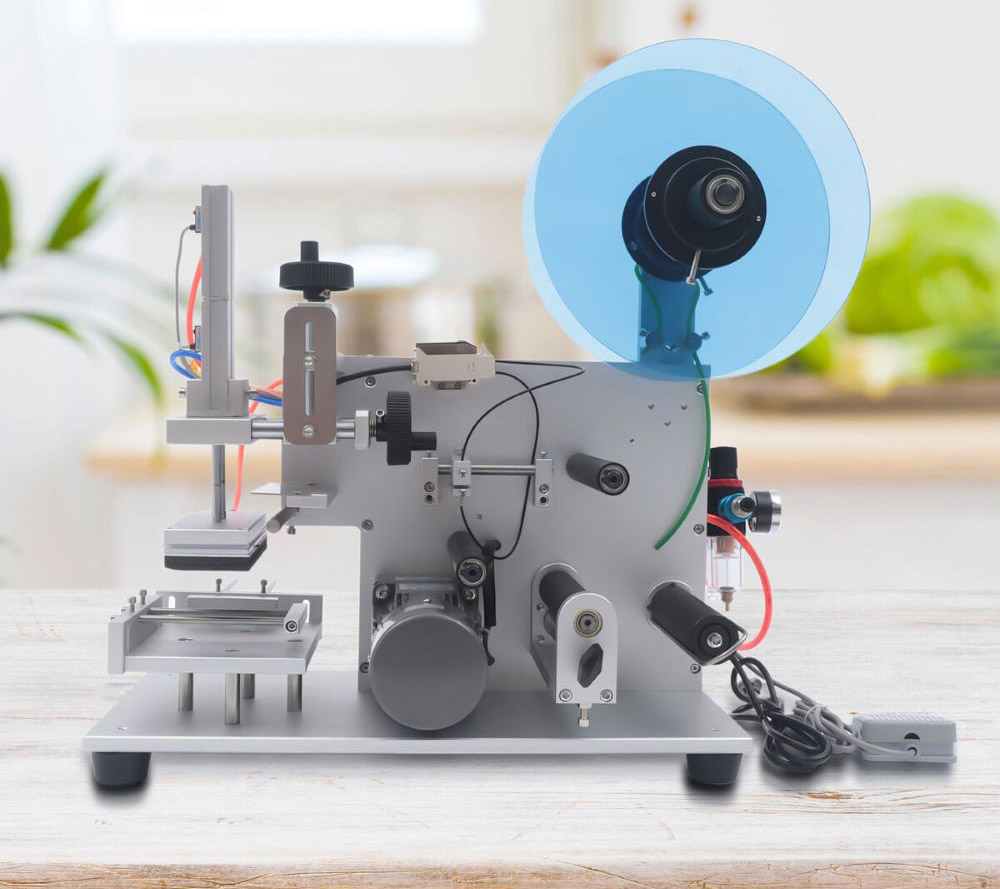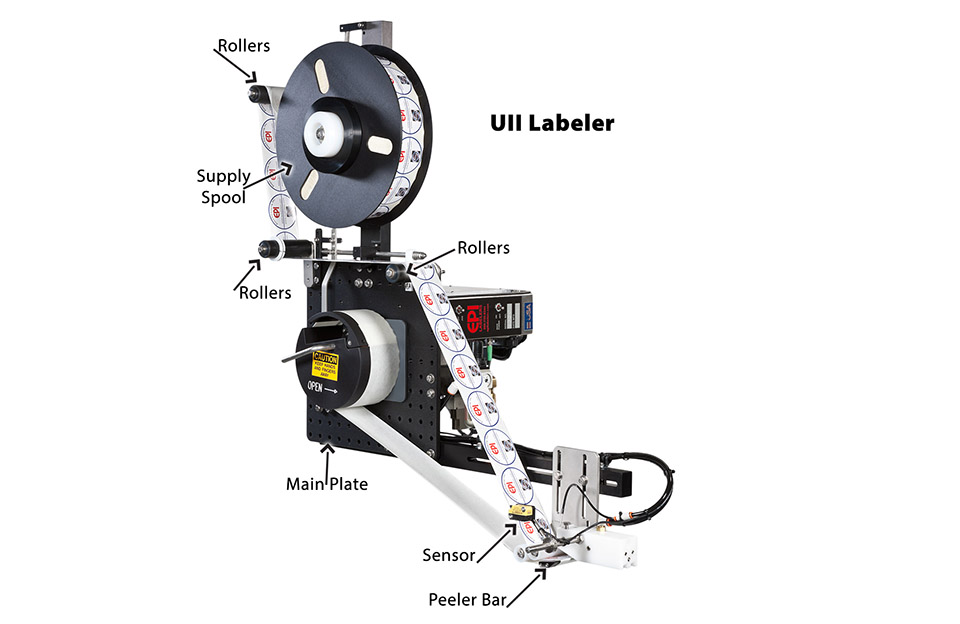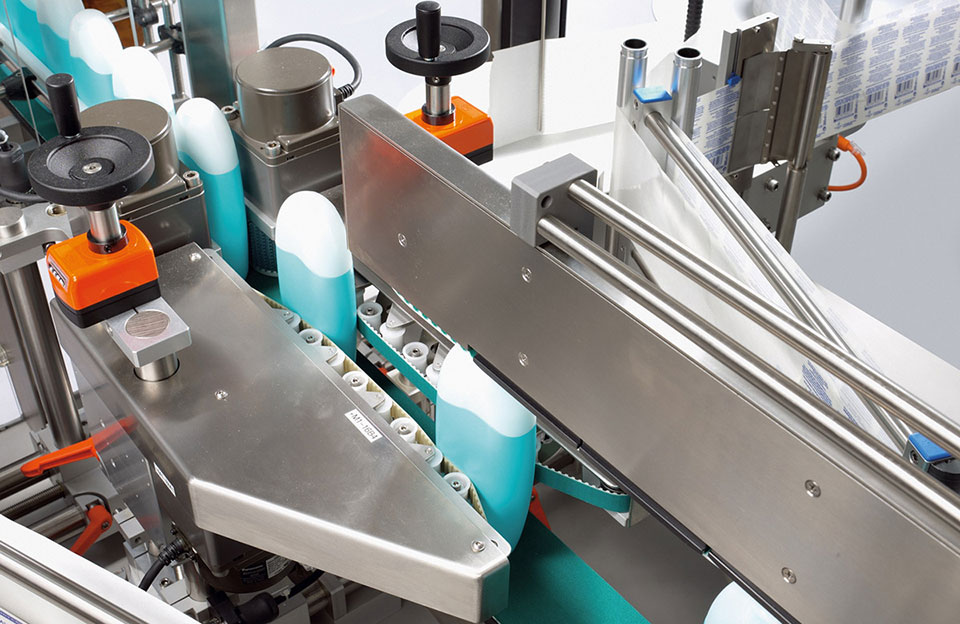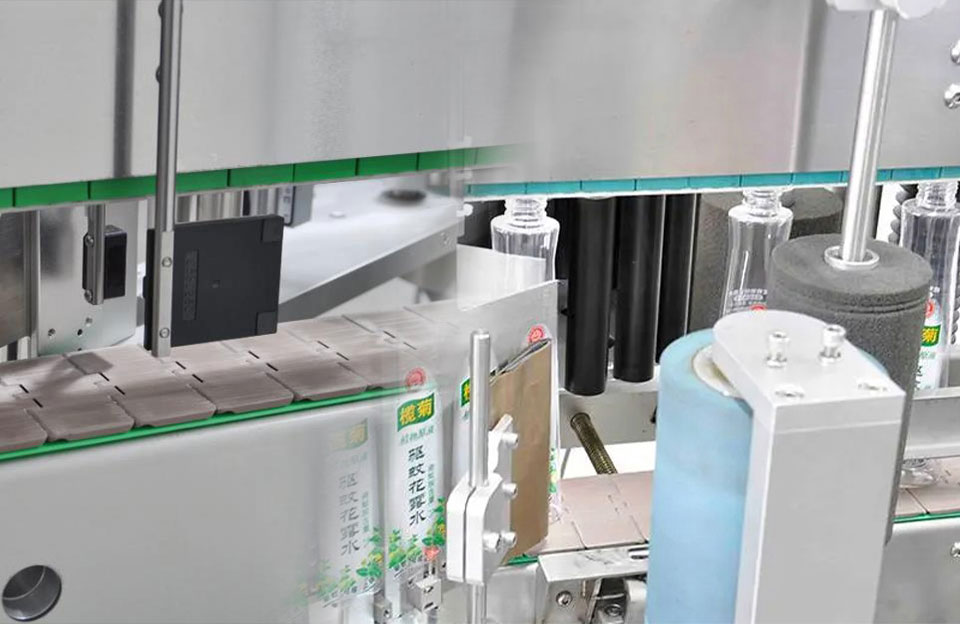The labeling head in the labeling machine is the most critical part of the whole machine. It plays a pivotal role in the efficient and accurate application of labels to products or packages in various industries.
The labeling head is designed to precisely position labels on products with consistency and accuracy. It is versatile and can accommodate various labeling methods, such as pressure-sensitive, tamp, blow-on, or wipe-on applicators.

Structure of Labeling Head in the Labeling Machine
The labeling head refers to a specific machine component responsible for applying labels to products or packages. The structure of the labeling head in the labeling machine can vary depending on the type of labeling technique and the application’s specific requirements. Here’s a general overview of the structure and components of a typical labeling head in the labeling machine:
- Label Roll Holder: The label roll holder is a spindle or mechanism designed to hold the label roll. The roll contains a continuous supply of labels that will be dispensed and applied to the products.
- Label Dispensing Mechanism: This mechanism is responsible for unwinding the label from the roll, guiding it through the labeling head, and precisely positioning it for application to the product. The label is usually dispensed with the help of rollers, guides, and sensors to ensure accurate positioning.
- Label Dispensing Mechanism: This mechanism is responsible for unwinding the label from the roll, guiding it through the labeling head, and precisely positioning it for application to the product. The label is usually dispensed with the help of rollers, guides, and sensors to ensure accurate positioning.
- Labeling Applicator: The labeling applicator is one of the key components of the labeling head in the labeling machine, and its design depends on the labeling method employed. Common types of labeling applicators include:
- Pressure-Sensitive Applicators: These applicators use a rubber or foam pad and a backing plate to apply labels with pressure to adhere them to the products.
- Tamp Applicators: Tamp applicators use a pneumatic or mechanical arm to precisely press the label onto the product. They are commonly used for flat or slightly irregular surfaces.
- Blow-on Applicators: These applicators use compressed air to blow labels onto products, suitable for non-contact labeling on fragile or sensitive items.
- Wipe-on Applicators: Wipe-on applicators use a rotating or oscillating brush or pad to apply labels to products as they pass by on a conveyor.
- Product Sensor: A product sensor is used to detect the presence of a product or package as it approaches the labeling head. This information triggers the labeling head to apply the label appropriately, ensuring accurate and consistent labeling.
- Control System: The labeling head in the labeling machine is controlled by a dedicated control system that coordinates the label dispensing, application, and synchronization with the product movement on the conveyor. The control system may use various sensors and actuators to achieve precise labeling.
- Adjustment Mechanisms: Labeling machines often have adjustable components in the labeling head to accommodate different product sizes and label positions. These adjustments allow operators to fine-tune the labeling applicator’s position, angle, and pressure for optimal label placement.

Labeling Head
The Working Process of Labeling Head in the Labeling Machine
The working process of the labeling head in the labeling machine involves a series of coordinated actions to accurately apply labels to products or packages as they move along the production line. The process can vary depending on the type of labeling machine and the labeling technique used, but here’s a general overview of the working process of labeling head in the labeling machine:
- Label Roll Preparation: The labeling process starts with loading the label roll onto the label roll holder. The roll contains a continuous supply of labels wound around a core.
- Label Dispensing: The label dispensing mechanism in the labeling head unwinds the label from the roll and feeds it into the assembly. The label is usually guided through rollers and guides to ensure smooth and precise movement.
- Product Detection: As the products or packages move along the conveyor, they pass through a product sensor. The product sensor detects the presence of a product and sends a signal to the control system, indicating that a product is ready for labeling.
- Label Application: Based on the signal from the product sensor, the control system activates the labeling applicator at the appropriate moment. The type of applicator used (pressure-sensitive, tamp, blow-on, wipe-on, etc.) will depend on the labeling technique employed.
- Label Placement: The Labeling Applicator accurately positions the label onto the product’s surface according to the predetermined label placement parameters. This step may involve adjusting the applicator’s position, angle, and pressure to match the product’s size and shape.
- Label Adhesion: Once the label is in the correct position on the product, the labeling applicator applies the necessary pressure or mechanism (e.g., a rubber pad, brush, or compressed air) to ensure proper label adhesion to the product’s surface.
- Repeat for Next Product: After labeling a product, the conveyor continues to move, and the product sensor detects the next item, starting the labeling process again. The labeling head works continuously, applying labels to products as they move through the machine.
- Label Roll Monitoring: The machine’s control system monitors the label roll’s status throughout the labeling process. If the label roll runs low or out, the system will signal the operator to replace the roll to avoid any interruptions in the labeling process.
- Adjustments and Calibration: The labeling head in the labeling machine may have adjustable components allowing operators to calibrate and fine-tune the label application for different product sizes and positions. These adjustments ensure accurate and consistent labeling results.
Conclusion
The labeling head in the labeling machine plays a crucial role in the automated application of labels to products or packages. It relies on precise sensors, control systems, and labeling applicators to achieve accurate label placement and consistent labeling throughout the production line.
The efficient functioning of the labeling head contributes to high-quality labeled products and optimized production processes. Its role in maintaining quality, compliance, branding, and cost-effectiveness makes it a key factor in modern manufacturing and packaging processes.


